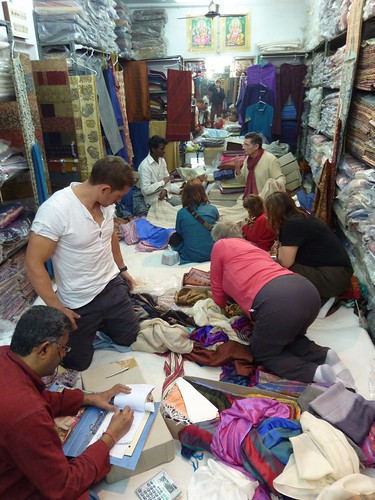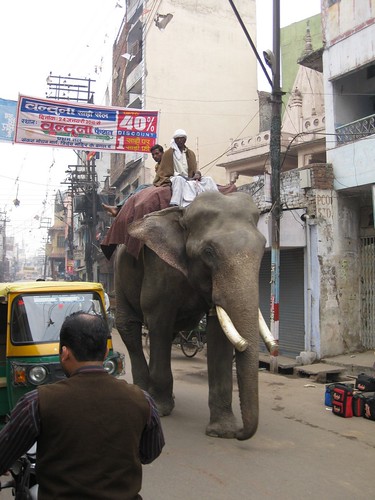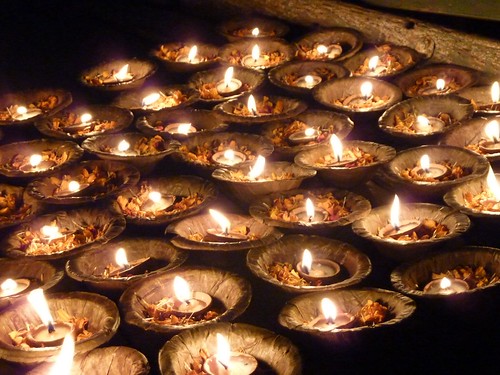We arrived in Varanasi after a two hour drive starting at the tiny village where we’d come ashore from our cruise down the Ganges. I didn’t have a great start – we had about 45 minutes in the hotel to freshen up before reporting back downstairs. I was looking forward to a hot shower, but our hotel room failed to deliver that luxury, and I was feeling a bit cranky and frayed by the time we set out for Sarnath, the place where the Buddha gave his first sermon. We were to travel there by autorickshaw, about half an hour each way, leaving us an hour or so at the site.The traffic in India really has to be experienced to be believed, and in Varanasi it was as bad as we’d seen anywhere. I think the fundamental problem is that no Indian driver will tolerate spending even a few seconds behind a slower vehicle. This means that everyone is constantly jockeying for position, squeezing through the tiniest spaces in a never-ending cross between ballet and demolition derby. At any given moment your autorickshaw might be overtaking three bicycles and a cow, while simultaneously being passed by six motorcycles that magically slide into a space that appears impossible and disappears immediately. Sometimes this means shortcutting around the near side of a roundabout, and in the most extreme cases can even involve slipping over to the other side of the road and travelling for a while in the opposing lane. It’s… invigorating, to say the least.
And the honking. Every action is accompanied by not one, but about seven honks. Coming up behind someone? Honk honk honk honk honk honk honk. Passing them from behind? Honk honk honk honk honk honk honk. Approaching an oncoming vehicle? Honk honk honk honk honk honk honk. Basically any action other than proceeding forward on an empty stretch of road requires a long string of honks. And because there are no empty stretches of road, there is NEVER a time when there’s no honking. Multiply this by the number of vehicles on the road and you can understand why driving in India is as much an assault on the ears as the nerves. My favourite are the horns that sound like dying ducks – it’s like they’re so overworked they’ve gone hoarse.
All this is not to downplay the smell of course. Exhaust, pollution, smoke, incense, dust… I could almost picture my lungs shriveling and turning black. If I clean out my nose with a bit of white issue the resulting black smears are disheartening, and Patti has been coughing up a lung since she arrived.
As I mentioned, our trip to Sarnath was supposed to take about thirty minutes, but the traffic in Varanasi on that day was exceptionally bad so we spent an hour in transit both ways. That left us about twenty minutes at the actual site before we had to turn around, with heavy hearts, to get back into the autorickshaws again. The whole event ended up being much more about the journey than the destination, which was pleasant but certainly not worth two hours in an autorickshaw.That evening before supper we went out onto the Ganges again, this time in a small rowboat, to have a look at the famous ghats. A ghat is simply an area along the river with steps built right down to the water’s edge – a place where you can get down to the Ganges. There are 102 spots like this in Varanasi, and they sort of blend one into the next.
 Janki Ghat, as noted on the wall in the upper left.
Janki Ghat, as noted on the wall in the upper left.
We floated past one of the burning ghats as the sun was setting and you could see four or five bonfires in different stages, which was sort of chilling. Then our boatmen started lighting up a whole series of little floating candles which were were meant to release into the river, each with a wish attached. However, there were 101 of them (it’s an auspicious number), so eventually we were just getting through them, or releasing them with wishes like “I wish the mosquitos would go away”, or “I wish we could go have dinner.” (At least that’s what I was doing… everybody else was probably wishing for world peace and a cure for cancer and stuff.) Eventually we ended up at a ghat where a prayer ceremony was underway, and we watched that for a while, listening to the chanting and watching the priests – 5 of them – who performed a series of choreographed actions with large burning braziers and candelabra that left one impressed with their endurance and forearm strength, if nothing else.
We were back on the Ganges again the next morning to have a look at the ghats and travel all the way down to the largest of the burning ghats. It was a nice paddle, but I would have preferred to forgo the “sunrise” portion, which meant we had to be up at 5:00 am. What’s the big deal about sunrise anyways? Why not place a greater emphasis on getting a few more hours of sleep and a nice breakfast?
Actually, we did have a nice breakfast, and then went into the old city for a quick look around and a visit to a silk and cotton shop. Mr. Sunil gave us a nice little chat about the handloom process and taught us about warp and weft and how to tell pure silk from fake and about the different kinds of dyes and methods of dying. His business is one of the few left that still weaves on handlooms and prints on cotton with carved wooden blocks. It was another in the carpet factory / paper factory series of visits, but like the others it was fun and interesting and the pitch at the end was a nice soft sell.
 Knee-deep in samples, as Mr. Sunil writes up another order in the bottom left
Knee-deep in samples, as Mr. Sunil writes up another order in the bottom left
After that it was back into a cycle rickshaw for the trip to the main event of the afternoon – a movie! Akshay picked out one of the latest Bollywood blockbusters for us to go to, so we spent three hours in the theatre while the splendor of Bollywood splashed across the screen. But first we had a quick lunch, and just like anywhere the place to have a quick lunch in India is McDonald’s, of course. However, because India is a Hindu country McDonald’s serves no beef or pork products. In India, the Big Mac is replaced by the Chicken Maharaja Mac, which is what Patti had. In keeping with my status as temporary vegetarian, I had another popular offering, the Chatpata McAloo Tikka – a potato burger! It tasted just like you’d expect – a fried patty of mashed potato on a bun. And it came with fries. Let’s just say I had my full ration of carbs that day.
 Patti and the Chicken Maharajah Mac
Patti and the Chicken Maharajah Mac
The movie we saw, called “Veer” was a historical piece about our hero, Veer, the son and heir of the Pindari clan, and the struggle against British rule (Boo! Bad British!), and Veer’s Romeo and Juliet-like love for the daughter of the head of a rival family. There were lots of musical numbers and fights and songs, and Veer spent a good amount of time with his shirt off, and it was long enough that there was a decent amount of time for napping. The movie was almost all in Hindi, but since the plot was not exactly intricate, it wasn’t hard to keep up. At the end Akshay clarified a few points, but mostly it was just fun to watch it all go past, and it was a great break from the pace outside on the street.
That night, in the street outside the hotel, a wedding procession called a braat ceremony went by. We saw a few of these and they looked like a lot of fun. In the hours before the actual wedding, a big crowd of family and friends moves through the streets, accompanied by a sort of DJ truck with speakers a sometimes even a live band. And there are always lines of other people carrying big lamps on their heads – some of which just look like ordinary table lamps – strung together by their electrical cords and powered by a little generator truck that tags along behind the whole business. (And boy, I would not want to be one of those lamp-carrying people, not only because they looked heavy, but also because I had a close look at the wiring on a generator trucks and let’s just say it was not exactly up to code.) Every once in a while the procession would stop and you could just make out the people in the middle of the maelstrom, dancing and puling others in from the circle to join them. The groom follows along behind riding a horse (the bride misses all the fun because she’s tucked away in a secret spot with her closest attendants, awaiting the wedding ceremony). I think they also set off fireworks too, because we heard a few loud bangs from inside the hotel later that night. It all looked like a lot of fun, and it was cool that it was right out in the street.
 A fuzzy shot of the wedding procession
A fuzzy shot of the wedding procession
And that was Varanasi. We had a few nice dinners, and I managed to have one hot shower (out of three) and very very very early on the morning of the 10th we squeezed into a little minivan for a long and uncomfortable drive into Nepal, country number 22. Our time in India was laughably short; to spend only nine days in a country of 1.4 billion people is ridiculous. I saw a fraction of a fraction of the country, but I’m glad I saw what I did. And I still have to write about Steve’s Weird Food for India, so for you at least, it’s not over yet.





1 Comment:
Really enjoying your posts. I'm still laughing about the honking cars,
Post a Comment